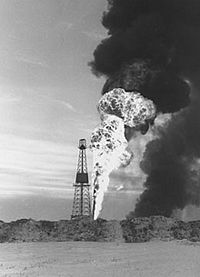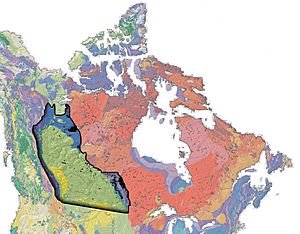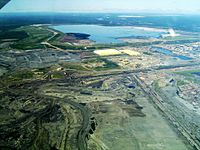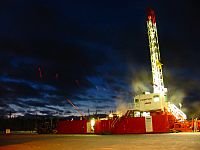Western Canadian Sedimentary Basin facts for kids
The Western Canadian Sedimentary Basin (WCSB) is a huge area of land in Western Canada. It covers about 1,400,000 square kilometers (540,000 square miles). This includes parts of Manitoba, Saskatchewan, Alberta, northeastern British Columbia, and the southwest Northwest Territories.
It's like a giant wedge of sedimentary rock that stretches from the Rocky Mountains in the west to the Canadian Shield in the east. This rock layer is about 6 kilometers (3.7 miles) thick near the Rocky Mountains. It gets thinner and thinner until it disappears on the eastern side.
The WCSB holds some of the world's biggest supplies of petroleum (oil) and natural gas. It provides a lot of energy for North America. In 2000, it produced over 16 billion cubic feet (450 million cubic meters) of gas every day! It also has huge amounts of coal. Most of the oil and gas, and almost all the oil sands, are found in Alberta.
Contents
Oil: Finding and Getting It Out

The WCSB has been explored for oil for a long time. Most new efforts now focus on natural gas and oil sands. There are two main types of oil found here: light crude oil and heavy crude oil. They are different to get out of the ground and sell.
Light Crude Oil: A Mature Industry
Light oil has been produced for many years. Most of the easy-to-reach light oil has already been taken out. Its production is slowly going down each year. Companies are looking for any oil left that hasn't been found yet. They are also drilling more wells in existing oil fields. They use special methods called enhanced oil recovery (EOR). These methods help push more oil out of the ground. Examples include pumping water, gas, or even carbon dioxide into the ground. Right now, only about 27% of the light oil is recovered. This means there's a lot more still underground that could be reached in the future.
Heavy Crude Oil: More Challenges
Heavy oil is also past its peak production. Its output is expected to go down over time. Companies are exploring new areas to find more heavy oil. They also use EOR methods for heavy oil. These can include water floods or heat-based projects. Only about 15% of heavy oil is currently recovered. This leaves a very large amount for future recovery.
New technology helps keep oil production going. Better ways to see underground (seismic technology) and improved drilling methods make it easier to find and get oil. This also helps companies get more oil from existing fields.
Oil Sands: A Huge Resource
The oil sands in Alberta hold a massive amount of oil. This oil is called bitumen. Experts say there are about 50 billion cubic meters (315 billion barrels) of bitumen that can be recovered. By the end of 2004, about 28 billion cubic meters (174 billion barrels) were still available.
The three main oil sands areas are:
- The Athabasca Oil Sands
- The Cold Lake Oil Sands
- The Peace River Oil Sands
These areas hold an amazing 260 billion cubic meters (1.6 trillion barrels) of oil. This is similar to all the regular oil reserves found worldwide! The World Energy Council reported in 2007 that Alberta's oil sands have at least two-thirds of the world's known bitumen. These oil sands reserves are much larger than those in regular oil fields. By 2007, the Alberta bitumen deposits provided over one-third of all the crude oil produced in Canada.
When oil prices went up, many new projects started in the oil sands. There are about 46 projects, with 135 different expansion phases. Building all these projects is expected to cost around $125 billion between 2006 and 2015. This huge amount of work has led to a shortage of workers in Alberta. This shortage is the main reason why oil sands production can't grow even faster.
Natural Gas: A Key Energy Source
Canada is one of the biggest producers and exporters of natural gas in the world. Most of this gas comes from the WCSB. It's estimated that the WCSB still has about 143 trillion cubic feet (4 trillion cubic meters) of gas that can be sold. This is about two-thirds of all Canadian gas reserves. More than half of the gas produced is sent to the United States.
However, Canada's gas reserves are less than one percent of the world's total. They are being used up quickly. Most of the large gas fields have already been found. A lot of the gas has already been taken out. Gas production from the WCSB reached its highest point in 2001. Since then, it has been expected to decline.
To keep production steady, about 3.8 billion cubic feet (107 million cubic meters) of new gas must be found each day. Since most of the basin has been explored, finding this much new gas is becoming harder. New gas in the WCSB will likely come from less common sources. One example is coalbed methane (CBM), which is gas found in coal seams.
The number of coalbed methane wells in Alberta more than doubled in 2005. By the end of that year, there were 7,764 wells. They produced almost 0.5 billion cubic feet (14 million cubic meters) of gas per day. Most of these wells are in the Horseshoe Canyon and Belly River formations. These are typically found at depths of 90 to 730 meters (300 to 2,400 feet).
Experts believe the WCSB will continue to be Canada's main gas supplier for many years. However, as production goes down, more gas might be used to power oil sands plants. This means there might not be enough extra gas to meet the needs of the United States.
Coal: Canada's Hidden Treasure
The WCSB holds about 90% of Canada's usable coal. This coal comes in different types, from soft lignite to hard semianthracite. About 36% of the estimated 71,000 megatonnes of usable coal is bituminous coal. This type of coal has low sulfur and good ash levels. This makes it useful for making coke, which is used in steel production. Large amounts of this coal are mined for that purpose.
However, there isn't much heavy industry in Western Canada that uses this coal. So, most of it is sent to other countries like Japan and Korea. The softer coals are mainly used to make electricity. These coal seams are often close to the surface. This makes strip-mining easy. It also makes it easier to fix the land afterward. The low sulfur levels in the coal also help reduce its impact on the environment.




